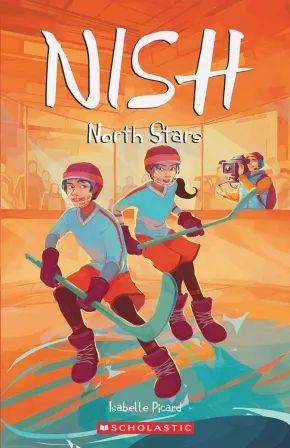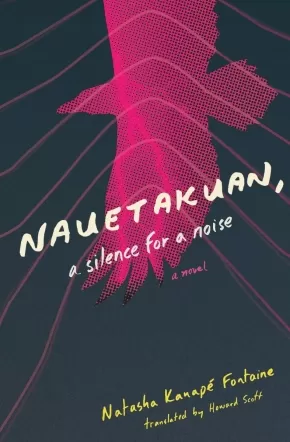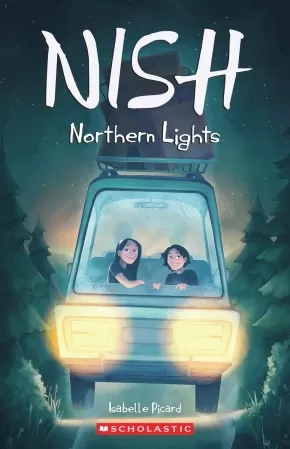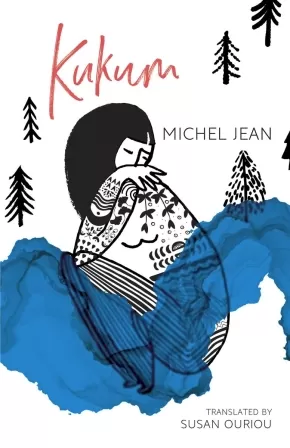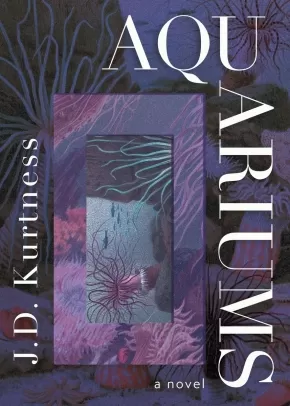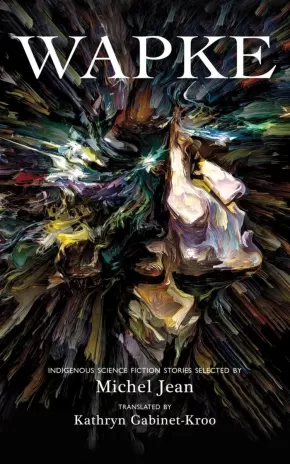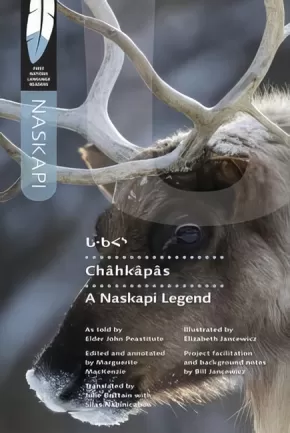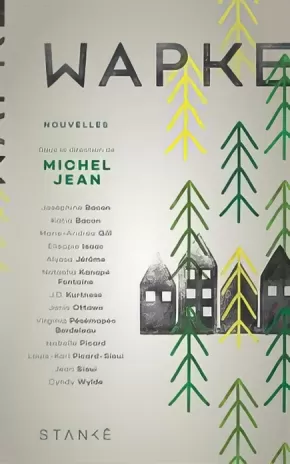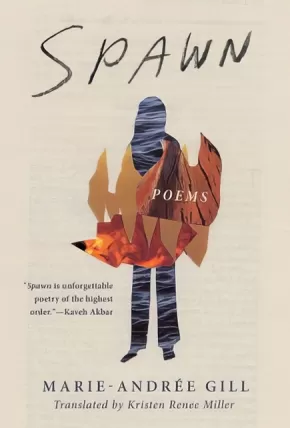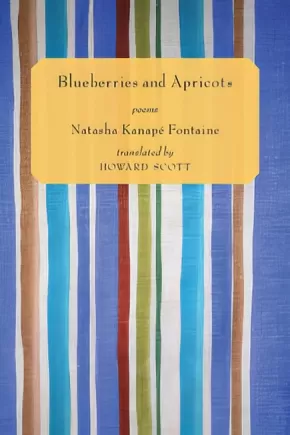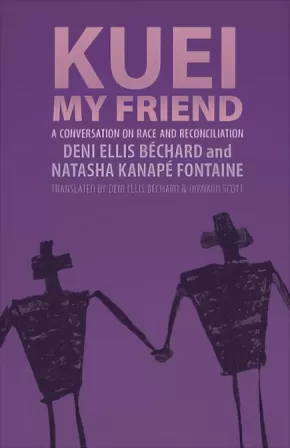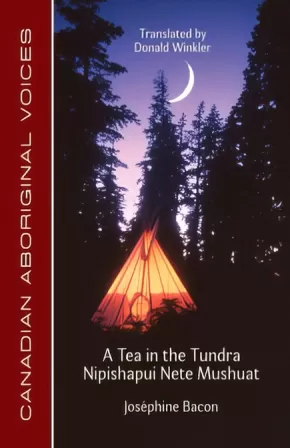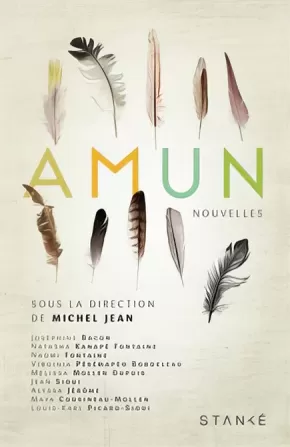Innu (Montagnais-Naskapi)
Synopsis:
Lights. Cameras. Hockey!
The school year is finally over and Eloise and Leon are back in Matimekush for the summer. But this school break will not be like any other, thanks to a hockey movie being filmed in the community! Is it possible that Leon will be in the movie? Will Eloise, who is interested in directing, participate in the project? Summer will be busy with twists and turns of all kinds for Leon, Eloise and their friends. It's the summer of possibilities!
Educator & Series Information
Recommended for ages 10 to 14.
Translated by Kateria Aubin Dubois, a freelance translator and a prolific beadworker. Her beadwork can be found under her Indigenous name, Nisnipawset. Kateri is from the Wolastoqiyik Wahsipekuk First Nation. She lives with her husband, two children and a fluffy cat in Terrebonne, Quebec.
This is the third book in the Nish series.
Additional Information
240 pages | 5.00" x 7.75" | Paperback
Synopsis:
"What's happening to you is just that the visible and the invisible are finding each other through you. You are the passageway for our reconnection. You and your generation are the ones who will give our memory back to us..."
Monica, a young woman studying art history in Montreal, has lost touch with her Innu roots. When an exhibition unexpectedly articulates a deep, intergenerational wound, she begins to search for a stronger connection to her Indigeneity. A quickly found friendship with Katherine, an Indigenous woman whose life is filled with culture and community, underscores for Monica the possibilities of turning from assimilation and toxic masculinity to something much deeper-and more universal than she expects.
Travelling across the continent, from Eastern Canada to Vancouver to Mexico City, Monica connects with other Indigenous artists and thinkers, learning about the power of traditional ways and the struggles of other Nations. Throughout these journeys, physical and creative, she is guided by visions of giant birds and ancestors, who draw her back home to Pessamit. Reckonings with family and floods await, but amidst strange tides, she reconnects to her language, Innu-aimun, and her people.
A timely and riveting story of reclamation, matriarchies, and the healing ability of traditional teachings, Nauetakuan, a silence for a noise underscores how reconnecting to lineage and community can transform Indigenous futures.
Reviews
"A love letter to residential school survivors dedicated to their descendants... To create the universe of Nauetakuan, populated by giant animals and marvelous creatures, including the thunderbird, Natasha Kanapé Fontaine was inspired by her own dreams, various native myths, and ancient legends taught to her by Joséphine Bacon." -Le Devoir
"Poet, singer, actress, and Innu activist, the talented Natasha Kanapé Fontaine has written her first hard-hitting novel this fall, which cuts through us like a lightning bolt." -Le Journal de Montréal
Educator Information
Translated by Howard Scott.
Additional Information
248 pages | 5.25" x 8.00" | Paperback
Synopsis:
The second book in Isabelle Picard’s bestselling coming-of-age series about Innu twins, Leon and Eloise.
Leon and Eloise are 13-year-old twins from Matimekush, an Innu community in Northern Quebec.
The entire Mckenzie family has moved to Wendake, near Quebec City. Leaving Matimekush, nature, their friends and their school is quite a challenge for Eloise and Leon. Between the adapting to a different world, their desire to make new friends and the need to keep their bond with the old ones, everything goes too fast.
At school, a student bullies Eloise, and she has to deal with this difficult situation. As for Leon, he starts doubting his hockey skills: Is he really talented or was he the best in Matimekush only because the competition simply wasn’t as strong? In the midst of this storm, Leon and Eloise can always count on each other as well as their family and friends.
The Mystery unfolds on every page as we get to see the twins in a different light. What if, ultimately, life in the South isn’t that different from life in the North?
Educator & Series Information
Recommended for ages 10 to 14.
Translated by Kateri Aubin Dubois, a freelance translator and a prolific beadworker. Her beadwork can be found under her Indigenous name, Nisnipawset. Kateri is from the Wolastoqiyik Wahsipekuk First Nation. She lives with her husband, two children and a fluffy cat in Terrebonne, Quebec.
This is the second book in the Nish series.
Additional Information
296 pages | 5.00" x 7.75" | Paperback
Synopsis:
A Quebec bestseller based on the life of Michel Jean's great-grandmother that delivers an empathetic portrait of drastic change in an Innu community.
Kukum recounts the story of Almanda Siméon, an orphan raised by her aunt and uncle, who falls in love with a young Innu man despite their cultural differences and goes on to share her life with the Pekuakami Innu community. They accept her as one of their own: Almanda learns their language, how to live a nomadic existence, and begins to break down the barriers imposed on Indigenous women. Unfolding over the course of a century, the novel details the end of traditional ways of life for the Innu, as Almanda and her family face the loss of their land and confinement to reserves, and the enduring violence of residential schools.
Kukum intimately expresses the importance of Innu ancestral values and the need for freedom nomadic peoples feel to this day.
Educator Information
Translated by Susan Ouriou.
Additional Information
224 pages | 5.50" x 8.50" | Paperback
Synopsis:
The first book in Isabelle Picard’s bestselling coming-of-age series about Innu twins, Léon and Éloïse.
In this acclaimed book, readers meet thirteen-year-old twins Leon and Eloise who live in Matimekush, an Innu community in Northern Quebec.
While Leon spends all his free time playing hockey, and wondering how he can prove he has the talent to make it big in a place with no competition, Eloise works on a school project that opens her mind to the history of her people — their victories and their battles lost.
But when their father gets sick and needs treatment almost 1000 km from home, and someone from their village mysteriously disappears, the twins learn lessons about the fragility of humanity and the dangers of the land they call home.
Educator & Series Information
Recommended for ages 10 to 14.
Translated by Kateri Aubin Dubois, a freelance translator and a prolific beadworker. Her beadwork can be found under her Indigenous name, Nisnipawset. Kateri is from the Wolastoqiyik Wahsipekuk First Nation. She lives with her husband, two children and a fluffy cat in Terrebonne, Quebec.
This is the first book in the Nish series.
Additional Information
304 pages | 5.00" x 7.75" | Paperback
Synopsis:
An intimate yet wide-sweeping story of a marine biologist working to save ocean ecosystems from climate change.
With the world’s oceans ravaged by climate change, Émeraude, a young marine biologist, works to preserve aquatic ecosystems by recreating them for zoos. When her work earns her a spot aboard a research vessel with an extended mission in the Arctic, it is the inescapable draw of the ocean that will save her when the world she leaves behind is irrevocably changed.
Stories of Émeraude’s ancestors — a young sailor abandoned at birth, a conjuror who mixes potions for her neighbours, a violent young man who hides in the woods to escape an even more violent war, and a talented young singer born to a mother who cannot speak — weave their way through her intimate reflections on a modest life, unknowingly shaped by those who came before.
Reviews
"Aquariums is a luminous, touching and comforting book, written with great clarity. In other words, a healing read. It can be read in a single sitting, and picked up again when one’s soul needs soothing." — Solaris
"J.D. Kurtness stands out on the indigenous literary scene for her unique style, inspired by dystopian and apocalyptic writing. In Aquariums, the author delivers a fragmented novel of filiation, mixing the different (non-)stories of a lineage and of the same generation, like an aquarium housing an ecosystem, to an apocalyptic end forcing a reset of the planetary population. Kurtness’s aesthetic is characterised by a holistic cosmic writing in which a sort of Glissant’s Tout-Monde is formed: the narratives of ancestors and the living communicate with the perceived and existing elements. This cosmic writing is conveyed through the fragmentary form, which is more organic than functional, the use of nature-related metaphors, that are tied to the life story of a whale, and the hybridity of the novel, which mixes the genres of life writing and dystopia. Although the author is Ilnu, the dimension of autochthony is not central to Aquariums. It is partially present in the discourse and the constellation of characters, but is not actively addressed." - Abstract from Dystopie, Fragmentation et Filiation dans Aquariums de J.D. Kurtness by Jody Danard
"This is a small book on a huge theme, set in various places and eras, featuring different perspectives. It could be confusing, but it works – so much so that I sometimes wished Kurtness had picked up some of her loose threads and developed the stories of Émeraude’s ancestors instead of returning to her protagonist’s journey. I want to know more about the scarred sailor, the blind shark, and the travelling whale. She dips her toe into the fantastical or the romantic and then pulls back, back to the science of a dying world. Aquariums is an inventive book on a grim not-so-distant future. In the end, Kurtness chooses to believe in the resilience of humanity. Like her ancestors before her, Émeraude will fight for her people’s future." - Roxane Hudon, Montreal Review of Books
Educator Information
Translated from French to English by Pablo Strauss
Additional Information
176 pages | 5.00" x 7.00" | Paperback
Synopsis:
Wapke—meaning “tomorrow” in the Atikamekw language—is Quebec’s first collection of science fiction short stories by Indigenous writers. Fourteen authors from various nations and different backgrounds project us into the future through their moving, poetic, worrying, and sometimes fantastical tales, addressing current social, political, and environmental themes. From time travelling Indigenous warriors to rebellious language and knowledge keepers, from Big Trees in a lake to a human sausage factory, from living on the land to living in cyberspace, these stories provide a trans-Indigenous colonial critique. The brainchild of Michel Jean, Wapke can be read on different levels: as pure entertainment for sci-fi fans or as a stimulant to serious reflection. It offers an often-captivating social commentary that reveals how Indigenous people view the future as well as a hope that change will come.
Educator Information
This book is available in French: Wapke
Additional Information
160 pages | 5.00" x 8.00" | Paperback
Synopsis:
Châhkâpâs: A Naskapi Legend shares the story of Châhkâpâs, a heroic figure in First Nations storytelling, who performs feats of strength and skill in spite of his diminutive size.
The book shares this traditional legend as originally recorded in the Naskapi community in northern Quebec in 1967 when it was narrated by John Peastitute, a Naskapi Elder and accomplished storyteller. Transcribed in the Naskapi language and syllabic orthography, the book offers a literary resource for the Naskapi language community, and the English translation enables those unfamiliar with the language, or the story, to discover this important legend.
The book also contains extensive analysis of stories about Châhkâpâs, notes about the provenance of the recordings, a biography of the storyteller, and a history of the Naskapi people. Lavish illustrations from Elizabeth Jancewicz—an artist raised in the Naskapi community—provide a sensitive and accurate graphical account of the legend, which has also been approved by Naskapi speakers themselves.
Educator & Series Information
This book is part of the First Nation Language Readers series. With a mix of traditional and new stories, each First Nations Language Reader introduces an Indigenous language and demonstrates how each language is used today.
By John Peastitute
Edited by Marguerite MacKenzie
Translated by Julie Brittain and Silas Nabinicaboo
Illustrated by Elizabeth Jancewicz
Contributions by Bill Jancewicz
Additional Information
264 pages | 6.00" x 9.00" | Paperback
Synopsis:
Wapke – « demain » en langue atikamekw – est le premier recueil de nouvelles d'anticipation autochtone publié au Québec. Quatorze auteurs de nations et d'horizons multiples se projettent dans l'avenir par le biais de la fiction, abordant des thèmes sociaux, politiques et environnementaux d'actualité. Sous la direction de Michel Jean, Wapke offre un commentaire social souvent saisissant où se dessine l'espoir d'un changement.
AVEC DES NOUVELLES INÉDITES DE Joséphine Bacon (Innue), Katia Bacon (Innue), Marie-Andrée Gill (Innue), Elisapie Isaac (Inuk), Michel Jean (Innu), Alyssa Jérôme (Innue), Natasha Kanapé Fontaine (Innue), J.D. Kurtness (Innue), Janis Ottawa (Atikamekw), Virginia Pésémapéo Bordeleau (Crie), Isabelle Picard (Wendat), Louis-Karl Picard-Sioui (Wendat), Jean Sioui (Wendat) et Cyndy Wylde (Anicinape et Atikamekw)
Educator Information
This book is available in English: Wapke: Indigenous Science Fiction Stories
Additional Information
216 Pages | Paperback
Synopsis:
Spawn is a braided collection of brief, untitled poems, a coming-of-age lyric set in the Mashteuiatsh Reserve on the shores of Lake Piekuakami (Saint-Jean) in Quebec. Undeniably political, Marie-Andrée Gill's poems ask: How can one reclaim a narrative that has been confiscated and distorted by colonizers?
The poet's young avatar reaches new levels on Nintendo, stays up too late online, wakes to her period on class photo day, and carves her lovers' names into every surface imaginable. Encompassing twenty-first-century imperialism, coercive assimilation, and 90s-kid culture, the collection is threaded with the speaker's desires, her searching: for fresh water to "take the edge off," for a "habitable word," for sex. For her "true north"—her voice and her identity.
Like the life cycle of the ouananiche that frames this collection, the speaker's journey is cyclical; immersed in teenage moments of confusion and life on the reserve, she retraces her scars to let in what light she can, and perhaps in the end discover what to "make of herself".
Reviews
"Spawn is an epic journey that follows the ouananiche in their steadfast ability to hold: rigid, shimmering, hardened to the frigid waters of winter, in all of its capacities of and for whiteness. Here, poems summon a spawn of wonderworking dreams: 'a woman risen up from all these winter worlds, heaped with ice [and] ready to start again'." —Joshua Whitehead, author of Jonny Appleseed
"Spawn is unforgettable poetry of the highest order." —Kaveh Akbar, author of Calling a Wolf a Wolf
"Gill's poems are like small treasures clutched in buried tree roots, preserving 'the chalky veins' of ancestral memory pulsing just below our modern hustle." —Kiki Petrosino, author of White Blood
Educator Information
Recommended in the Canadian Indigenous Books for Schools 2020/2021 resource list for grade 12 for English Language Arts and Social Justice.
Caution: Some foul language, sexual and violent content.
Additional Information
96 pages | 5.25" x 7.75" | Translated by Kristen Renee Miller
Synopsis:
In this, her third volume of poetry, this Aboriginal writer from Quebec again confronts the loss of her landscape and language.
On my left hip
a face
I walk
I walk upright
like a shadow
a people on my hip
a boatload of fruit
and the dream inside
women and children first
"A cry rises in me and transfigures me. The world waits for woman to come back as she was born: woman standing, woman powerful, woman resurgent. A call rises in me and I've decided to say yes to my birth."
Reviews
"Poetess, painter, actress, slammer ... Natasha Kanapé Fontaine speaks with a soft voice, but her words are powerful. In a few years, the young Innue has become a model for young people and for her community." —La Presse
Educator Information
Recommended in the Canadian Indigenous Books for Schools 2019-2020 resource list as being useful for grades 9-12 for English Language Arts and Social Studies.
Additional Information
72 pages | 5.00" x 7.50" | Translated from French by Howard Scott.
Synopsis:
Kuei, My Friend is an engaging book of letters: a literary and political encounter between Innu poet Natasha Kanapé Fontaine and Québécois-American novelist Deni Ellis Béchard. Choosing the epistolary form, they decided to engage together in a frank conversation about racism and reconciliation.
Intentionally positioned within the contexts of the Idle No More movement, Canada’s Truth and Reconciliation Commission, and the National Inquiry into Missing or Murdered Aboriginal Women and Girls, the letters in Kuei, My Friend pose questions in a reciprocal manner: how can we coexist if our common history involves collective and personal episodes of shame, injury, and anger? how can we counteract misunderstandings of the Other, which so often lead to contempt and rejection? how can we educate non-Indigenous communities about the impact of cultural genocide on the First Peoples and the invisible privileges resulting from historical modes of domination?
In an attempt to open a sincere and productive dialogue, Kanapé Fontaine and Ellis Béchard use their personal stories to understand words and behaviours that are racist or that result from racism. With the affection and intimacy of a friend writing to a friend, Natasha recounts to her addressee her discovery of the residential schools, her obsession with the Oka Crisis of 1990, and her life on the Pessamit reserve. Reciprocating, Deni talks about his father’s racism, the segregation of African-Americans and civil rights, and his identity as a Québécois living in the English-speaking world.
By sharing honestly even their most painful memories, these two writers offer an accessible, humanist book on the social bridge-building and respect for difference. Kuei, My Friend is accompanied by a chronology of events, a glossary of relevant terms in the Innu language, and, most importantly, a detailed teacher’s guide that includes topics of discussion, questions, and suggested reflections for examination in a classroom setting.
Educator Information
Recommended resource for Grades 10-12 in these areas: BC First Peoples, Contemporary Indigenous Studies, English First Peoples, English Studies, Literary Studies.
Includes an Innu-aimun glossary and a teacher's guide to help classroom discussion facilitation.
Recommended in the Canadian Indigenous Books for Schools 2019-2020 resource list as being useful for grades 10 to 12 for English Language Arts and Social Studies.
This resource is also available in French: Kuei, je te salue: Conversation sur le racisme.
Additional Information
176 pages | 6.21" x 8.46" | Translated by & Deni Ellis Béchard & Howard Scott
Synopsis:
In this bilingual English-Innu poetry collection, Joséphine Bacon challenges our traditional notions of culture and perception, landscape and wilderness, the limits of experience, and the nature of human being. With a surreal blend of emotions and memories, A Tea in the Tundra / Nipishapui Nete Mushuat portrays a complex and ever-shifting landscape of possibilities. The author passionately reveals a finely wrought sensibility, which elevates the subtle scenery of life's everyday events.
Educator & Series Information
This book is part of the Canadian Aboriginal Voices series.
Additional Information
96 pages | 5.50" x 8.50" | Translated by Donald Winkler
Synopsis:
Dans la langue innue, amun signifie « rassemblement ». Sous la direction de Michel Jean, écrivain et journaliste innu, ce collectif réunit pour la toute première fois des auteurs autochtones de divers horizons, de différentes nations et générations. Leurs textes de fiction reflètent tantôt l'histoire et les traditions, tantôt la réalité des Premières Nations au Québec et au Canada. Offrant à lire les points de vue d'artistes de renom, ce livre est le théâtre d'un rassemblement et d'une prise de parole qui ne se font que trop rarement.
Avec des nouvelles inédites de Joséphine Bacon, Natasha Kanapé Fontaine, Naomi Fontaine, Virginia Pésémapéo Bordeleau, Melissa Mollen Dupuis, Jean Sioui, Alyssa Jérôme, Maya Cousineau-Mollen, Louis-Karl Picard-Sioui et Michel Jean.
Additional Information
168 Pages | Paperback

